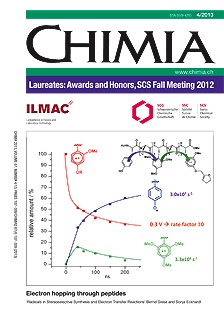[(Cp-R)M(CO)3] (M= Re or 99mTc) Conjugates for Theranostic Receptor Targeting
DOI:
https://doi.org/10.2533/chimia.2013.267Keywords:
Bioorganometallic chemistry, Carbonic anhydrase inhibitors, Radiopharmaceuticals, Technetium, TheranosticAbstract
Cyclopentadienyl complexes of 99mTc became accessible via a retro Diels-Alder synthetic approach of dimerized cyclopentadiene derivatives. So far, this approach was limited to derivatives comprising a carboxylic acid group, directly conjugated to the Cp-ring, leading to complexes [(C5H5COOH) 99m Tc(CO)3] and [(C5H5CONH-R)99mTc(CO)3], respectively. The introduction of an –NCO group via Curtius rearrangement and subsequent in situ reactions with alcohols or amines gave [(C5H5NHCO-OR)2] and [(C5H5NHCO-NHR)2]. To increase the spacer lengths between the Cp-ring and the functional groups, methylene and ethylene spacers were introduced to yield C5H5-CH2COOH and C5H5-C2H4COOH respectively. The latter Cp-derivatives reacted with [99mTcO4)]- and in the presence of CO releasing/reducing agents to the corresponding [(C5H5-spacer-COOH) 99mTc(CO)3] complexes. The carboxylato groups can be derivatized with targeting functions, leading to structurally altered receptor binding complexes, with 99mTc for imaging and with rhenium for therapy. The nature of the 99mTc complexes was assessed by HPLC comparison with the corresponding rhenium compounds.Downloads
Published
2013-04-24
Issue
Section
Scientific Articles
License
Copyright (c) 2013 Swiss Chemical Society

This work is licensed under a Creative Commons Attribution-NonCommercial 4.0 International License.
How to Cite
[1]
D. Can, P. Schmutz, S. Sulieman, B. Spingler, R. Alberto, Chimia 2013, 67, 267, DOI: 10.2533/chimia.2013.267.







